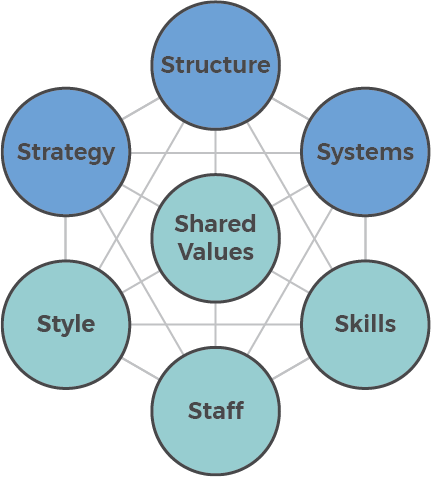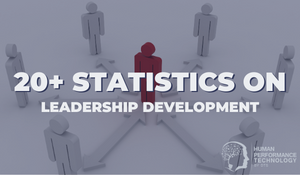Exploring the McKinsey 7S
This month, we continue developing and delivering a leadership program for one of our customers. Many of these leaders are new to the role, and this is a fast-growing company by acquisitions. Senior leadership is looking for this group of frontline leaders and their teams to contribute more actively to strategy execution.
To help these new leaders consider how they can contribute to strategy, manage change, and juggle their various leadership priorities, we decided to introduce the McKinsey 7S. From a frontline leaders' perspective, it was interesting to consider what is usually a model reserved for senior leadership.
The McKinsey 7S was developed in the 1980s by two McKinsey & Company consultants, Robert Waterman and Tom Peters. The model explores 7 elements (or “levers”) an organisation should seek to align to be successful. The seven elements are Strategy, Structure, Systems, Staff, Style, Skills, and Shared Values (originally called, Superordinate Goals).
Strategy, Structure and Systems are referred to as the “hard” elements. They are called “hard” elements because they are relatively easy to identify and can be influenced directly. Staff, Style, Skills, and Shared Values are considered the “soft” elements, as they are harder to identify and influence directly.
The McKinsey 7S is typically shown as a diagram resembling an atom, with the seven elements connected by a series of lines.

Recreated from the original model displayed in the article, 'Structure is Not Organisation', published in Business Horizons in 1980.
A few key things to note about the diagram:
- Shared Values is placed in the centre because it is considered to influence all of the others.
- All seven elements are the same size to illustrate that all elements are equally important and should all be given the same weight.
- A line connects all seven elements to each of the other six. This is designed to reflect that a movement on one element has a knock-on effect on the others.
The McKinsey 7S is a valuable framework to help implement new strategy, facilitate organisational change, course correct strategy, facilitate a merger, and explore how each area may change in the future. We love this model because it is relatively simple and easy to remember, yet so impactful. It is difficult to think of an internal element that will impact an organisation's effectiveness, that does not fit within the framework.
In our following blog post, we take a deeper dive into each of the seven elements and how we might think about them as a leader of a frontline team. Click here to view.
References
Peters, T., Waterman, R. & Phillips, J. 1980, 'Structure is Not Organisation', Business Horizons, p14-26
Peters, T. & Waterman, R. 2012, In Search of Excellence: Lessons from America's Best-Run, Harper Business
McKinsey Quarterly, 2008, Enduring Ideas: The 7-S Framework, McKinsey & Company, accessed 15 February 2023, <https://www.mckinsey.com/capabilities/strategy-and-corporate-finance/our-insights/enduring-ideas-the-7-s-framework>
Malan, Adele. Applying McKinsey's 7S Model Within Managed Healthcare Systems (MHS) to Assess the Organisation's Effectiveness and Ability to Adapt, 2003, Rand Africanns University
Abdul-Fattah Alshaher, Ali. The McKinsey 7S Model Framework for E-Learning System Readiness Assessment, 2013, College of Administration and Economics, University of Mosul, Iraq.
Mind Tools n.d., McKinsey 7-S Framework, accessed 15 February 2023, <https://www.mindtools.com/aicks4s/the-mckinsey-7-s-framework>
Cascade 2022, McKinsey 7S Model: Importance & How To Use It (2023), accessed 15 February 2023, <https://www.cascade.app/blog/mckinsey-7s-model>
Skills You Need n.d., The McKinsey 7 S Model of Organisational Alignment, accessed 16 February 2023, <https://www.skillsyouneed.com/lead/mckinsey-7-s.html>
Ovidijus Jurevicius 2022, McKinsey 7S Model, Strategic Management Insight, accessed 16 February 2023, <https://strategicmanagementinsight.com/tools/mckinsey-7s-model-framework/>
Malik, Priyanka, 2022, The McKinsey 7-S Model Framework, Explained, WhatFix, accessed 15 February 2023, <https://whatfix.com/blog/mckinsey-7s-model>
Kenton, Will, 2022, How to Use the McKinsey 7-S Model for Strategic Planning, Investopedia, accessed 17 February 2023, <https://www.investopedia.com/terms/m/mckinsey-7s-model.asp>

Trevor O'Sullivan
General Manager. Since the early 2000s, Trevor has worked with thousands of Talent Management professionals to develop and apply assessment-based talent management solutions for selecting, developing and managing people. Trevor is an active member of the TTI Success Insights (TTISI) Global Advisory Council, contributes to TTISI product development and is a regular presenter at TTISI-R3. He is honoured to have received multiple Blue Diamond Awards and, more recently, the Bill Brooks Impact Award recognising his contributions to the TTISI global network.



We Would Like to Hear From You (0 Comments)